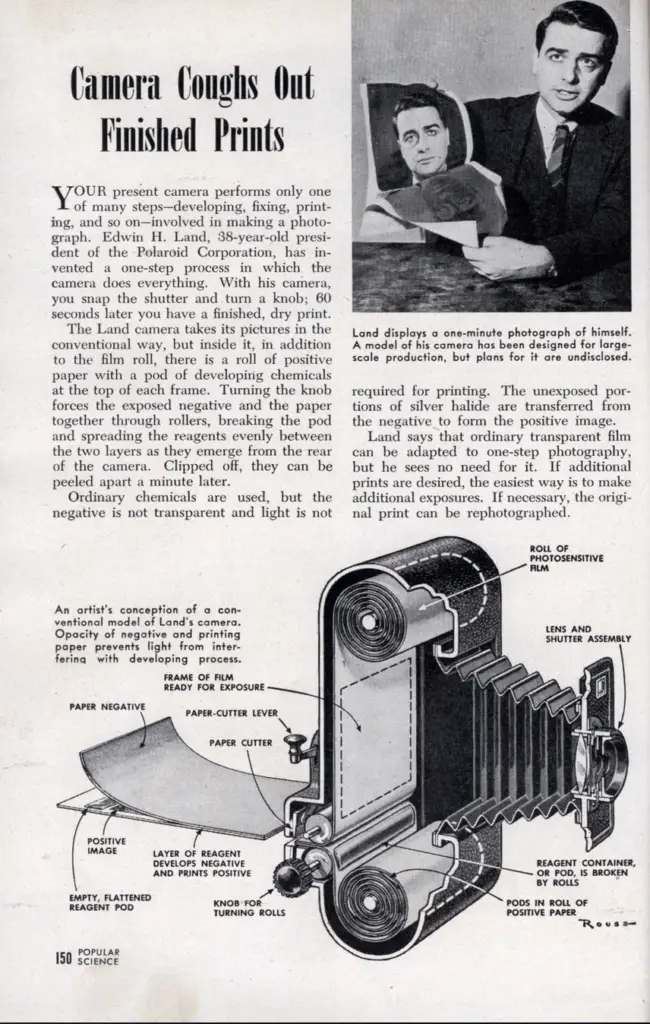Polaroid photos, and other instant films, are a magical way to capture a moment even with digital photography allowing us to see the photo instantly. Polaroid pictures are prized for the unique look they create automatically and prized because they creates a print in seconds you can hold in your hand. This is something that digital cameras can’t do. Since most people don’t know how the image appears, or how “Polaroid ink” works, questions can be raised about whether a Polaroid picture is actually toxic or not.
Contrary to popular belief, a Polaroid photo does not use ink to create an image. Instead, there is a reagent, a mixture of chemicals that react with specific layers that make up the film. The chemicals in the film packet are not toxic in small amounts but should not be consumed intentionally.
What Is a Polaroid Instant Photo?

A Polaroid picture is an instantly developed photo taken by a camera. Polaroid is the most notable company of the film type but other companies like Fujifilm make a similar product. Polaroid pictures come it all shapes and sizes but the most notable is the square format with a white frame area at the bottom Polaroid film
is the most notable company of the film type but other companies like Fujifilm make a similar product. Polaroid pictures come it all shapes and sizes but the most notable is the square format with a white frame area at the bottom Polaroid film measure 4.2 inches tall and 3.5 inches wide with the image area being square at 3.1 inches by 3.1 inches. The picture itself is made of a unique film that consists of a plastic sheet with chemicals inside.
measure 4.2 inches tall and 3.5 inches wide with the image area being square at 3.1 inches by 3.1 inches. The picture itself is made of a unique film that consists of a plastic sheet with chemicals inside.
The Polaroid camera first debuted in 1948 and developed by E dward Land,
dward Land,  an American inventor who revolutionized film because his daughter wondered why she had to wait so long to see their vacation images. He also served as inspiration for Steve Jobs. At the time, traditional photographic film had to be taken to a lab to be developed (or done at home), which took several hours and/or days before you could see your image. The Polaroid instant film camera
an American inventor who revolutionized film because his daughter wondered why she had to wait so long to see their vacation images. He also served as inspiration for Steve Jobs. At the time, traditional photographic film had to be taken to a lab to be developed (or done at home), which took several hours and/or days before you could see your image. The Polaroid instant film camera allowed people to see their picture 60 seconds after taking it
allowed people to see their picture 60 seconds after taking it

Over time, the popularity of instant film has gone through ups and downs. However, even with digital cameras and cell phones, Polaroid and other instant film brands are making a comeback because of their unique aesthetic.
are making a comeback because of their unique aesthetic.
What’s Inside a Polaroid Picture?
What used to be inside a Polaroid picture in 1948 is quite different from what it contains today .
.
In 2008, there was a decline in the popularity of instant cameras due to the rise of digital photography . Chemical manufacturers who only produced material for instant film had to close. When instant film regained popularity there were no manufacturers left to produce the same chemicals used in the film and some chemicals were no longer available for large-scale production. The Impossible Project, which tried to save Polaroid and the instant film process, eventually merged with The Polaroid Company in 2017
. Chemical manufacturers who only produced material for instant film had to close. When instant film regained popularity there were no manufacturers left to produce the same chemicals used in the film and some chemicals were no longer available for large-scale production. The Impossible Project, which tried to save Polaroid and the instant film process, eventually merged with The Polaroid Company in 2017 and has reignited the struggling company and film type.
and has reignited the struggling company and film type.
As a result, Polaroid and other brands like Fujifilm had to create a new formula. While the formula may have changed, the mechanism of developing an instant photo has not.
Inside the plastic Polaroid photo’s casing in modern instant films, are layers of light-sensitive silver grains. There are also layers of developing chemicals, dye couplers, as well as an image, timing, and acid layer.
What triggers the photo to develop is the reagent. The reagent is a mixture of Opacifiers, Alkali, and White Pigment
The reagent layer is between the light-sensitive layer and the image layer. Before the photo is taken, the reagent mixture is at the edge of the picture under the white, bottom border of the picture frame. Once you push the button to take the picture, the film slides between a pair of rollers. The rollers spread the reagent all over the film sheet. Each element of the reagent mixture reacts with a specific chemical layer. As the chemical reactions take place, depending on what film you put into the camera , a color or black and white image comes into view. (Source: Polaroid)
, a color or black and white image comes into view. (Source: Polaroid)
Everything is contained inside a plastic lining, so simply holding a Polaroid photo poses no harm. However, if the plastic lining is broken, the chemicals inside can come out.
Is A Polaroid Picture Toxic?
While the chemicals in a Polaroid picture aren’t not harmful in small amounts, you don’t want to be ingesting or getting them on your skin.
One of the main “chemicals” used inside Polaroid film is alkaline . If it comes in contact with your skin or mouth, it can cause irritation or a burning sensation; however, it will not pose any immediate threat. You just need to wash it off with soap and water as soon as possible and you will be okay.
. If it comes in contact with your skin or mouth, it can cause irritation or a burning sensation; however, it will not pose any immediate threat. You just need to wash it off with soap and water as soon as possible and you will be okay.
Is A Polaroid Picture Poisonous?
But what about the chemical is poisonous? Poisonous means the substance has to enter your body to do harm. For example, a poison dart frog has chemicals on its skin. Holding a poison dart frog won’t hurt you but licking one can.
In this sense, alkali can be poisonous if ingested in a large enough quantity. However, since you’re unlikely to eat your Polaroid photos, chances are you won’t be poisoned by it. Just make sure to keep it away from small children and pets who are more likely to do so if left unattended.
If a small child or pet does manage to ingest it, please don’t hesitate to contact Poison Control online or at 1-800-222-1222 as it can be toxic.
online or at 1-800-222-1222 as it can be toxic.
Is It Safe to Cut Polaroid Photos?
Cutting a Polaroid photo breaks the plastic lining, which can release the liquid that it is designed to contain. It is safe to cut a Polaroid photo, but it is recommended to wash your hands if you get any of the chemicals inside on you.
The more significant risk of cutting a Polaroid photo—especially right after taking the picture—is that it may cause the picture to deteriorate faster. Once that plastic seal is broken, the air interacts with the chemicals inside and cause the image to fade. However, if the picture is older, chances are the chemicals have been long neutralized within the Polaroid and will be less likely affected by cutting it open.
Related Article: How To Keep Your Instant Film From Fading And How To Display It?
Is a Polaroid Picture Flammable? Is It Safe to Burn?
While Polaroid and other instant films are very flammable, when you burn the chemicals inside toxic fumes are released into the air. In addition, burning plastic releases carcinogens, which can cause cancer. There is also a risk that the fire will spread if it’s not contained. So, to be safe, it is best not to burn Polaroid Photos but if you must burn it go outside where there is plenty of air circulation.
What If I Get the Chemicals on My Hands?
The chemicals inside a Polaroid picture, or any other instant film, are not harmful in limited amounts and are most harmful if ingested. If you get the chemicals from inside Polaroid film on your hands, immediately wash your hands with warm soap and water.
